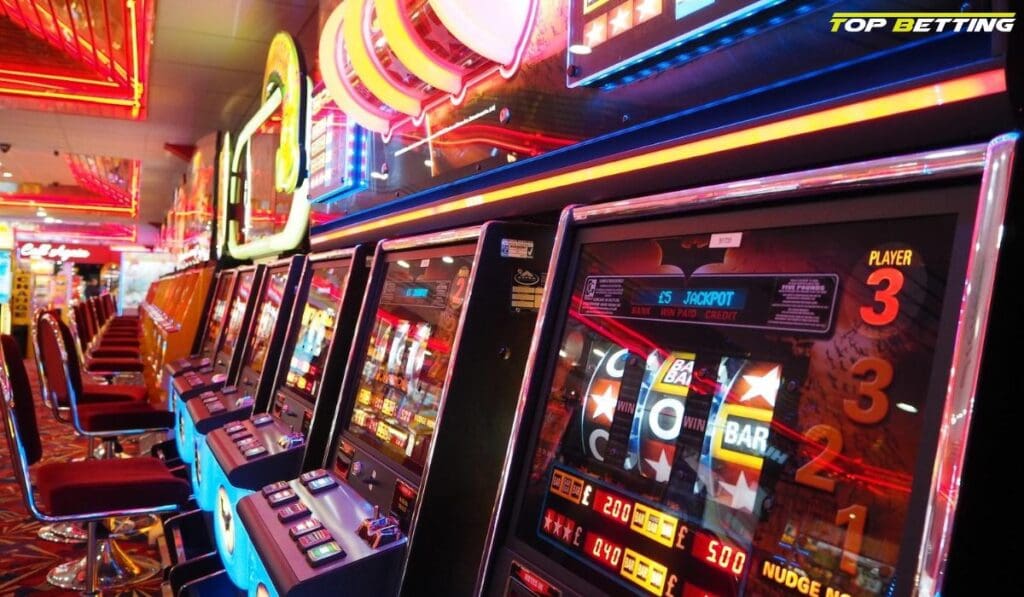
What Makes Slot Machines So Addictive | Is it really
Step into any casino and you’ll find a captivating world filled with flashing lights, ringing bells, and rows upon rows of slot machines. These gambling devices have become an integral part of casino culture, drawing in players with their enticing promises of fortune. But have you ever wondered why slot machines are so addictive?
In this article, we will delve into the science behind slot machine addiction and explore the psychological and physiological factors that make them so alluring. From the colorful graphics and cheerful sounds to the intermittent reinforcement and near-misses, every aspect of these machines has been carefully designed to keep players hooked.
By understanding the mechanisms behind slot machine addiction, we can gain insights into our own behavior and make informed decisions when it comes to gambling. In addition, this knowledge can contribute to the development of effective strategies for preventing and treating gambling addiction. Join us as we uncover the secrets behind the allure of slot machines, and discover the fascinating science that lies beneath the surface of this captivating casino game. Get ready to glimpse into the intriguing world of slot machine addiction.
Understanding the psychology behind slot machine addiction
Slot machines are not just random games of chance they are meticulously designed to exploit certain aspects of human psychology. One of the key factors that make these machines addictive is the concept of intermittent reinforcement. Unlike traditional forms of gambling, such as playing cards or roulette, slot machines provide unpredictable rewards. This irregular pattern of rewards taps into our brain’s reward system, triggering the release of dopamine, a neurotransmitter associated with pleasure and motivation.
The anticipation of a potential win activates the brain’s reward system and releases dopamine, creating a pleasurable sensation. This dopamine rush reinforces the behavior of playing the slot machine, making players crave more of that pleasurable feeling. Additionally, the near-miss phenomenon, where players come close to winning but fall just short, further stimulates the brain’s reward system. These near-misses give players a false sense of hope, fueling their desire to keep playing in the hopes of achieving that elusive win.
The design of slot machines also plays a significant role in their addictive nature. The vibrant colors, flashing lights, and engaging sound effects create an immersive and stimulating environment. These sensory cues enhance the overall gambling experience and increase the player’s emotional arousal. The constant stimulation keeps players engaged and focused on the game, making it difficult for them to disengage and walk away.
The role of dopamine in slot machine addiction
Dopamine, often referred to as the “feel-good” neurotransmitter, plays a central role in the addictive nature of slot machines. When a player engages in a slot machine game, the brain’s reward system is activated, leading to the release of dopamine. This release of dopamine creates a pleasurable sensation, reinforcing the behavior of playing the slot machine and increasing the likelihood of continued play.
Research has shown that individuals with gambling disorders have abnormalities in their dopamine systems. These abnormalities can lead to a heightened sensitivity to the rewarding effects of gambling, making it more difficult for individuals to resist the urge to play. The constant release of dopamine during slot machine play can create a cycle of reward-seeking behavior, making it challenging for individuals to quit even when faced with negative consequences.
Understanding the role of dopamine in slot machine addiction is crucial for developing effective treatment strategies. By targeting the dopamine system, researchers and clinicians can develop medications and therapies that help individuals overcome their gambling addiction and regain control over their lives.
The impact of reward systems on slot machine addiction
Slot machines are designed to exploit the brain’s reward system by providing intermittent reinforcement. This concept of intermittent reinforcement is based on the idea that occasional rewards are more powerful motivators than consistent rewards. When playing a slot machine, players experience a mix of wins and losses, with the occasional big win acting as a powerful reward.
This unpredictable pattern of rewards creates a sense of excitement and anticipation, keeping players engaged and motivated to continue playing. The intermittent reinforcement also makes it difficult for players to predict when the next reward will occur, leading to a constant craving for the next win.
In addition to intermittent reinforcement, slot machines often incorporate bonus features and jackpots, which further enhance the reward system. These additional rewards provide players with a sense of achievement and satisfaction, reinforcing their desire to keep playing.
Design elements that make slot machines addictive
The design of slot machines plays a significant role in their addictive nature. Every aspect of these machines, from the graphics and sounds to the placement and layout, is carefully crafted to maximize player engagement and retention.
The colorful graphics and vibrant animations used in slot machines are designed to capture the player’s attention and create an immersive experience. The visual appeal of these machines is crucial in attracting and retaining players, as it creates a sense of excitement and anticipation.
Sound effects also play a vital role in the addictive nature of slot machines. The ringing bells, cheerful melodies, and celebratory sounds that accompany wins create a positive and rewarding auditory experience. The sounds of a winning combination trigger the release of dopamine, reinforcing the pleasurable sensation associated with playing the slot machine.
The placement and layout of slot machines within a casino are strategically planned to maximize player exposure. High-traffic areas, such as entrances and walkways, are often filled with slot machines to capture the attention of passing players. The proximity of these machines to other enticing features, such as restaurants or bars, further increases their visibility and accessibility.

How slot machine addiction affects the brain
Slot machine addiction can have profound effects on the brain, altering the brain’s structure and function. Prolonged exposure to the stimulating environment of slot machines can lead to changes in the brain’s reward system, making it more difficult for individuals to experience pleasure from activities not related to gambling.
Studies have shown that individuals with gambling addiction exhibit reduced grey matter in the prefrontal cortex, a region of the brain responsible for decision-making and impulse control. This reduction in grey matter can impair an individual’s ability to resist the urge to gamble, making it challenging to quit even when faced with negative consequences.
Slot machine addiction can also lead to increased activity in the brain’s reward system, specifically in the ventral striatum. This heightened activity can create a cycle of reward-seeking behavior, making it difficult for individuals to quit gambling even when they are aware of the negative consequences.
The social and economic consequences of slot machine addiction
Slot machine addiction can have far-reaching social and economic consequences, affecting not only the individuals struggling with addiction but also their families, communities, and society as a whole.
Financial problems are one of the most significant consequences of slot machine addiction. Individuals with gambling addiction often spend excessive amounts of money on slot machines, leading to financial instability, debt, and even bankruptcy. The financial strain can put a significant burden on individuals and their families, leading to increased stress, conflict, and breakdowns in relationships.
Slot machine addiction can also have a negative impact on mental health. The constant cycle of anticipation, wins, and losses can lead to heightened levels of anxiety and stress. The shame and guilt associated with gambling addiction can further exacerbate mental health issues, leading to depression, isolation, and even suicidal thoughts.
Communities that are heavily reliant on revenue from gambling establishments may also suffer from the social consequences of slot machine addiction. Local economies can become dependent on gambling revenue, leading to a cycle of economic boom and bust. This reliance on gambling can perpetuate the cycle of addiction, as communities may prioritize economic gains over the well-being of their residents.
Treating and managing slot machine addiction
Treating slot machine addiction requires a multidimensional approach that addresses the psychological, physiological, and social aspects of the addiction.
Cognitive-behavioral therapy (CBT) is often used to treat gambling addiction. This therapy focuses on identifying and challenging the irrational beliefs and thought patterns that contribute to addictive behaviors. By helping individuals develop healthier coping mechanisms and strategies, CBT can assist individuals in managing their cravings and resisting the urge to gamble.
Medications may also be used to help individuals overcome slot machine addiction. Anti-addiction medications, such as naltrexone, can help reduce cravings and the pleasurable effects of gambling. These medications work by blocking the brain’s opioid receptors, reducing the rewarding effects of gambling and making it less enticing.
Support groups, such as Gamblers Anonymous, can provide individuals with a supportive community of people who understand their struggles. These groups offer a safe space for individuals to share their experiences, receive guidance, and gain insight from others who have successfully overcome their gambling addiction.

Responsible gambling practices to prevent addiction
Prevention is key when it comes to slot machine addiction. By adopting responsible gambling practices, individuals can minimize their risk of developing an addiction and maintain control over their gambling behavior.
Setting limits is an essential aspect of responsible gambling. Individuals should establish a budget for gambling activities and stick to it. Setting a limit on the amount of time spent gambling can also help prevent excessive play and reduce the risk of addiction.
Self-awareness is another crucial aspect of responsible gambling. Individuals should regularly assess their gambling behavior and be honest with themselves about any signs of addiction. Recognizing the warning signs early on can help individuals seek help and support before the addiction spirals out of control.
Seeking help and support is vital for individuals who feel they may be developing a gambling problem. Talking to a trusted friend, family member, or professional can provide the necessary guidance and support to overcome the addiction.

Conclusion
Slot machines have a powerful allure that can captivate and ensnare players, leading to addiction and its associated consequences. The science behind slot machine addiction reveals the intricate ways in which these machines exploit human psychology and reward systems. Understanding the psychological and physiological factors that contribute to addiction is crucial for developing effective prevention and treatment strategies.
By shedding light on the science of slot machine addiction, we hope to empower individuals to make informed decisions when it comes to gambling. Whether it’s setting limits, seeking help, or adopting responsible gambling practices, individuals can take control of their gambling behavior and mitigate the risk of addiction. Let’s strive for a world where the allure of slot machines is understood and respected, and where individuals can enjoy gambling without falling into the grips of addiction.











